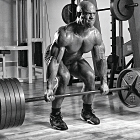 Q: What muscles does the deadlift train?
Q: What muscles does the deadlift train?
A: There are four main forms of the deadlift. Done properly, they are among the most effective bodybuilding movements.
The conventional deadlift is the bent-legged form, performed with the hands wider apart than the legs.
The sumo deadlift requires a wider stance and the hands inside the legs.
The parallel-grip deadlift requires a trap bar or a shrug bar and is an excellent alternative to the barbell squat for bodybuilders whose leverages aren’t well suited to squatting. The parallel-grip deadlift has been a godsend for many bodybuilders.
The last variation is the stiff-legged deadlift. I don’t recommend the full-range version, but I do recommend the partial stiff-legged deadlift—from just below knee height. The Romanian deadlift is a form of the partial stiff-legged deadlift.
For most bodybuilders the conventional deadlift is the most technically demanding of the variations, and the partial deadlift is the least.
If the deadlift involves substantial knee flexion, the quadriceps are heavily involved, but if it doesn’t, the quads aren’t involved to any great extent.
Aside from possible quads involvement, the other muscles that participate in deadlifts include the spinal erectors, buttocks, hamstrings, latissimus dorsi, upper back (including the traps) and forearms. The bent-legged forms of the deadlift train more than half of the muscle mass of the body.
When performed correctly, deadlifts are highly valuable bodybuilding exercises, but if you don’t do them correctly, they’re among the most dangerous exercises. In other words, deadlift correctly, or don’t deadlift at all.
Most bodybuilders who don’t deadlift correctly don’t know correct deadlifting technique, but the bodies of some bodybuilders just aren’t capable of adopting correct technique.
To be able to deadlift competently with any of the variations, you need to work at deadlifting technique and the essential supportive work.
There are three major components of good deadlifting ability:
1) The flexibility to be able to adopt the correct body position
2) The back strength to be able to maintain the correct back position
3) Correct exercise technique
You need to have sufficient flexibility in the major musculature of your lower body, so work on it. Without sufficient flexibility, your deadlifting technique will be compromised, with a reduction in safety and effectiveness.
You need sufficient strength throughout your back—lower, middle and upper—to be able to hold your lower back in the required slightly hollowed position during the deadlift. That’s critical for safety. Your back must not round while deadlifting. Four back exercises—the deadlift itself, back extensions, rows and shrugs—will help build the required back strength provided you work them with correct form and progressive resistance.
It may take several months before you can implement correct deadlifting technique, even with minimal weight. Don’t be frustrated. As your flexibility and back strength improve, along with your ability to use them, so will your deadlifting ability. Until you can adopt the correct technique, keep the resistance very light.
As your deadlifting weight grows, so should your strength on the back extensions, rows and shrugs to help you maintain the correct back positioning.
Here’s a critical note for all forms of the deadlift: The greater the extent of the forward lean, the greater the risk to the back because of the increased chance of losing the slightly concave lower spine that’s essential for safe deadlifting. To try to minimize the risk from deadlifting, keep your maximum forward lean to 45 degrees from an imaginary vertical line. There has to be forward lean in order to involve the back musculature heavily, but you must avoid excessive forward lean.
—Stuart McRobert
www.Hardgainer.com
Editor’s note: Stuart McRobert’s first byline in IRON MAN appeared in 1981. He’s the author of the new BRAWN series, Book 1: How to Build Up to 50 Pounds of Muscle the Natural Way, available from Home Gym Warehouse, (800) 447-0008 or www.Home-Gym.com.




















You must be logged in to post a comment Login